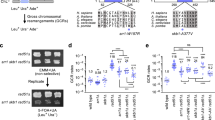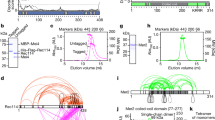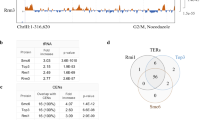Abstract
Of the three structural maintenance of chromosome (SMC) complexes, two directly regulate chromosome dynamics. The third, Smc5/6, functions mainly in homologous recombination and in completing DNA replication. The literature suggests that Smc5/6 coordinates DNA repair, in part through post-translational modification of uncharacterized target proteins that can dictate their subcellular localization, and that Smc5/6 also functions to establish DNA-damage-dependent cohesion. A nucleolar-specific Smc5/6 function has been proposed because Smc5/6 yeast mutants display penetrant phenotypes of ribosomal DNA (rDNA) instability. rDNA repeats are replicated unidirectionally. Here, we propose that unidirectional replication, combined with global Smc5/6 functions, can explain the apparent rDNA specificity.
This is a preview of subscription content, access via your institution
Access options
Subscribe to this journal
Receive 12 print issues and online access
$189.00 per year
only $15.75 per issue
Buy this article
- Purchase on Springer Link
- Instant access to full article PDF
Prices may be subject to local taxes which are calculated during checkout

Similar content being viewed by others
References
Losada, A. & Hirano, T. Dynamic molecular linkers of the genome: the first decade of SMC proteins. Genes Dev. 19, 1269–1287 (2005).
Lehmann, A. R. et al. The rad18 gene of Schizosaccharomyces pombe defines a new subgroup of the SMC superfamily involved in DNA repair. Mol. Cell. Biol. 15, 7067–7080 (1995).
Cost, G. J. & Cozzarelli, N. R. Smc5p promotes faithful chromosome transmission and DNA repair in Saccharomyces cerevisiae. Genetics 172, 2185–2200 (2006).
De Piccoli, G. et al. Smc5–Smc6 mediate DNA double-strand-break repair by promoting sister-chromatid recombination. Nature Cell Biol. 8, 1032–1034 (2006).
Harvey, S. H., Sheedy, D. M., Cuddihy, A. R. & O'Connell, M. J. Coordination of DNA damage responses via the Smc5/Smc6 complex. Mol. Cell. Biol. 24, 662–674 (2004).
Hu, B. et al. Qri2/Nse4, a component of the essential Smc5/6 DNA repair complex. Mol. Microbiol. 55, 1735–1750 (2005).
McDonald, W. H., Pavlova, Y., Yates, J. R. & Boddy, M. N. Novel essential DNA repair proteins Nse1 and Nse2 are subunits of the fission yeast Smc5–Smc6 complex. J. Biol. Chem. 278, 45460–45467 (2003).
Morikawa, H. et al. Rad62 protein functionally and physically associates with the Smc5/Smc6 protein complex and is required for chromosome integrity and recombination repair in fission yeast. Mol. Cell. Biol. 24, 9401–9413 (2004).
Pebernard, S., McDonald, W. H., Pavlova, Y., Yates, J. R. & Boddy, M. N. Nse1, Nse2, and a novel subunit of the Smc5–Smc6 complex, Nse3, play a crucial role in meiosis. Mol. Biol. Cell 15, 4866–4876 (2004).
Potts, P. R., Porteus, M. H. & Yu, H. Human SMC5/6 complex promotes sister chromatid homologous recombination by recruiting the SMC1/3 cohesin complex to double-strand breaks. EMBO J. 25, 3377–3388 (2006).
Torres-Rosell, J. et al. SMC5 and SMC6 genes are required for the segregation of repetitive chromosome regions. Nature Cell Biol. 7, 412–419 (2005).
Verkade, H. M., Bugg, S. J., Lindsay, H. D., Carr, A. M. & O'Connell, M. J. Rad18 is required for DNA repair and checkpoint responses in fission yeast. Mol. Biol. Cell 10, 2905–2918 (1999).
Pebernard, S., Wohlschlegel, J., McDonald, W. H., Yates, J. R. & Boddy, M. N. The Nse5–Nse6 dimer mediates DNA repair roles of the Smc5–Smc6 complex. Mol. Cell. Biol. 26, 1617–1630 (2006).
Lindroos, H. B. et al. Chromosomal association of the Smc5/6 complex reveals that it functions in differently regulated pathways. Mol. Cell 22, 755–767 (2006).
Ampatzidou, E., Irmisch, A., O'Connell, M. J. & Murray, J. M. Smc5/6 is required for repair at collapsed replication forks. Mol. Cell. Biol. 26, 9387–9401 (2006).
Miyabe, I., Morishita, T., Hishida, T., Yonei, S. & Shinagawa, H. Rhp51-dependent recombination intermediates that do not generate checkpoint signal are accumulated in Schizosaccharomyces pombe rad60 and smc5/6 mutants after release from replication arrest. Mol. Cell. Biol. 26, 343–353 (2006).
Strom, L., Lindroos, H. B., Shirahige, K. & Sjogren, C. Postreplicative recruitment of cohesin to double-strand breaks is required for DNA repair. Mol. Cell 16, 1003–1015 (2004).
Unal, E. et al. DNA damage response pathway uses histone modification to assemble a double-strand break-specific cohesin domain. Mol. Cell 16, 991–1002 (2004).
Strom, L. et al. Postreplicative formation of cohesion is required for repair and induced by a single DNA break. Science 317, 242–245 (2007).
Unal, E., Heidinger-Pauli, J. M. & Koshland, D. DNA double-strand breaks trigger genome-wide sister-chromatid cohesion through Eco1 (Ctf7). Science 317, 245–248 (2007).
Onoda, F. et al. SMC6 is required for MMS-induced interchromosomal and sister chromatid recombinations in Saccharomyces cerevisiae. DNA Repair 3, 429–439 (2004).
Mengiste, T., Revenkova, E., Bechtold, N. & Paszkowski, J. An SMC-like protein is required for efficient homologous recombination in Arabidopsis. EMBO J. 18, 4505–4512 (1999).
Andrews, E. A. et al. Nse2, a component of the Smc5–6 complex, is a SUMO ligase required for the response to DNA damage. Mol. Cell. Biol. 25, 185–196 (2005).
Potts, P. R. & Yu, H. Human MMS21/NSE2 is a SUMO ligase required for DNA repair. Mol. Cell. Biol. 25, 7021–7032 (2005).
Zhao, X. & Blobel, G. A SUMO ligase is part of a nuclear multiprotein complex that affects DNA repair and chromosomal organization. Proc. Natl Acad. Sci. USA 102, 4777–4782 (2005).
Potts, P. R. & Yu, H. The SMC5/6 complex maintains telomere length in ALT cancer cells through SUMOylation of telomere-binding proteins. Nature Struct. Mol. Biol. 14, 581–590 (2007).
Branzei, D. et al. Ubc9- and mms21-mediated sumoylation counteracts recombinogenic events at damaged replication forks. Cell 127, 509–522 (2006).
Lee, K. M. et al. Brc1-mediated rescue of Smc5/6 deficiency: requirement for multiple nucleases and a novel Rad18 function. Genetics 175, 1585–1595 (2007).
Sheedy, D. M. et al. Brc1-mediated DNA repair and damage tolerance. Genetics 171, 457–468 (2005).
Chin, J. K., Bashkirov, V. I., Heyer, W. D. & Romesberg, F. E. Esc4/Rtt107 and the control of recombination during replication. DNA Repair 5, 618–628 (2006).
Roberts, T. M. et al. Slx4 regulates DNA damage checkpoint-dependent phosphorylation of the BRCT domain protein Rtt107/Esc4. Mol. Biol. Cell 17, 539–548 (2006).
Rouse, J. Esc4p, a new target of Mec1p (ATR), promotes resumption of DNA synthesis after DNA damage. EMBO J. 23, 1188–1197 (2004).
Sergeant, J. et al. Composition and architecture of the Schizosaccharomyces pombe Rad18 (Smc5–6) complex. Mol. Cell. Biol. 25, 172–184 (2005).
Torres-Rosell, J. et al. Anaphase onset before complete DNA replication with intact checkpoint responses. Science 315, 1411–1415 (2007).
Kobayashi, T. & Ganley, A. R. Recombination regulation by transcription-induced cohesin dissociation in rDNA repeats. Science 309, 1581–1584 (2005).
Thorburn, W. M. Occam's razor. Mind 24, 287–288 (1915).
Aono, N., Sutani, T., Tomonaga, T., Mochida, S. & Yanagida, M. Cnd2 has dual roles in mitotic condensation and interphase. Nature 417, 197–202 (2002).
Chen, E. S., Sutani, T. & Yanagida, M. Cti1/C1D interacts with condensin SMC hinge and supports the DNA repair function of condensin. Proc. Natl Acad. Sci. USA 101, 8078–8083 (2004).
Boddy, M. N. et al. Replication checkpoint kinase Cds1 regulates recombinational repair protein Rad60. Mol. Cell. Biol. 23, 5939–5946 (2003).
Morishita, T., Tsutsui, Y., Iwasaki, H. & Shinagawa, H. The Schizosaccharomyces pombe rad60 gene is essential for repairing double-strand DNA breaks spontaneously occurring during replication and induced by DNA-damaging agents. Mol. Cell. Biol. 22, 3537–3548 (2002).
Fousteri, M. I. & Lehmann, A. R. A novel SMC protein complex in Schizosaccharomyces pombe contains the Rad18 DNA repair protein. EMBO J. 19, 1691–1702 (2000).
Palecek, J., Vidot, S., Feng, M., Doherty, A. J. & Lehmann, A. R. The Smc5–Smc6 DNA repair complex. Bridging of the Smc5–Smc6 heads by the kleisin, Nse4, and non-kleisin subunits. J. Biol. Chem. 281, 36952–36959 (2006).
Ivanov, D. & Nasmyth, K. A physical assay for sister chromatid cohesion in vitro. Mol. Cell 27, 300–310 (2007).
de Lange, T. Shelterin: the protein complex that shapes and safeguards human telomeres. Genes Dev. 19, 2100–2110 (2005).
Borden, K. L. Pondering the promyelocytic leukemia protein (PML) puzzle: possible functions for PML nuclear bodies. Mol. Cell. Biol. 22, 5259–5269 (2002).
Author information
Authors and Affiliations
Corresponding author
Related links
Rights and permissions
About this article
Cite this article
Murray, J., Carr, A. Smc5/6: a link between DNA repair and unidirectional replication?. Nat Rev Mol Cell Biol 9, 177–182 (2008). https://doi.org/10.1038/nrm2309
Issue Date:
DOI: https://doi.org/10.1038/nrm2309
This article is cited by
-
Investigating the effects of chronic low-dose radiation exposure in the liver of a hypothermic zebrafish model
Scientific Reports (2023)
-
Smc5/6 functions with Sgs1-Top3-Rmi1 to complete chromosome replication at natural pause sites
Nature Communications (2021)
-
Interaction between NSMCE4A and GPS1 links the SMC5/6 complex to the COP9 signalosome
BMC Molecular and Cell Biology (2020)
-
Specialized interfaces of Smc5/6 control hinge stability and DNA association
Nature Communications (2017)
-
Genetic evidence for functional interaction of Smc5/6 complex and Top1 with spatial frequency of replication origins required for maintenance of chromosome stability
Current Genetics (2017)



